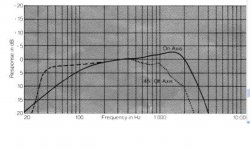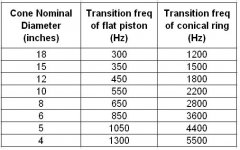Over what frequency range is it most efficient.
Ed if you can extract efficiency (conversion of electrical to acoustic energy) from this data please elaborate.
Good questions! 15" rated size. Yes you can get relative efficiency not absolute!
Without knowing the real part of the woofer's impedance how so? I don't think one of the plots is labeled, is there something missing.
Without knowing the real part of the woofer's impedance how so? I don't think one of the plots is labeled, is there something missing.
If we had a perfect piston in an infinite baffle what would the frequency response look like?
If we had a perfect piston in an infinite baffle what would the frequency response look like?
What's your favorite color?
There is no information given on the electrical energy needed to drive either.
What's your favorite color?
There is no information given on the electrical energy needed to drive either.
Pickled Banana!
Let us drive the piston with a DC electric motor with a constant voltage source and infinite current.
If we had a perfect piston in an infinite baffle what would the frequency response look like?
OK I'll try to answer in the general terms the question is asked.
There will be a roll off in the bass due to the springiness of the suspension, a linear section in the middle, followed by a roll off due to the combined effects of cone mass & coil inductance.
Is that answer too simple ?
If we had a perfect piston in an infinite baffle what would the frequency response look like?
Please stop it, Ed.
Actually Pavel when I mentioned this at a meeting of transducer manufacturers they found the answer surprising.
Now if you look at the graph you will see that the output rises at 6 db/octave from 20 to 100 hertz. The rise begins to slow above that and the frequency response is almost flat from 200 to 500 hertz. It begins to rise above that and finally rolls off.
Now a perfect motor would drive a piston to a 6 db/octave rising slope. For a constant voltage the current required would rise as more work is being done.
So for the woofer shown the efficiency begins to drop at 100 hertz and is 13 db down from perfect response at 800 hertz. If the woofer were 100% efficient from 20 to 100 hertz at 800 hertz it would be 5%.
As a transducer is reversible input to output, the damping factor control of the power amplifier would be swamped by the effective series resistance that could be used to model the drop in efficiency.
In simple words as the frequency rises above 100 hertz the output drops, this is due to the "mass break" in the driver, cone losses (Break Up) and other issues.
In the days where you only looked at frequency response the longer the flat line the better. With DSP (or fairly simple analog circuitry) you can use this loudspeaker from 20 to 100 hertz and have a maximally efficient woofer. You would have to limit excursion to prevent damage as the cone will not be effectively loaded at lower frequencies.
Above 100 hertz as the efficiency of the woofer drops, the distortion rises.
In large system efficiency is key. Now when we use small area fill loudspeakers for locations such as under balcony fill they are typically classic design or using the lower efficiency to get flat response. They do not sound the same as the DSP controlled high efficiency types. Not surprisingly the measured distortion is much higher.
So this woofer would be usable to about 200 hertz.
You can match this with a midrange driver that also has the correct slope. When you get to a tweeter, the choices are much smaller, but as the distortion products are reaching the limits of hearing it is not as important.
Now the sound difference is that when the woofer is better controlled, the midrange is improved.
ES
Now if you look at the graph you will see that the output rises at 6 db/octave from 20 to 100 hertz. The rise begins to slow above that and the frequency response is almost flat from 200 to 500 hertz. It begins to rise above that and finally rolls off.
Now a perfect motor would drive a piston to a 6 db/octave rising slope. For a constant voltage the current required would rise as more work is being done.
So for the woofer shown the efficiency begins to drop at 100 hertz and is 13 db down from perfect response at 800 hertz. If the woofer were 100% efficient from 20 to 100 hertz at 800 hertz it would be 5%.
As a transducer is reversible input to output, the damping factor control of the power amplifier would be swamped by the effective series resistance that could be used to model the drop in efficiency.
In simple words as the frequency rises above 100 hertz the output drops, this is due to the "mass break" in the driver, cone losses (Break Up) and other issues.
In the days where you only looked at frequency response the longer the flat line the better. With DSP (or fairly simple analog circuitry) you can use this loudspeaker from 20 to 100 hertz and have a maximally efficient woofer. You would have to limit excursion to prevent damage as the cone will not be effectively loaded at lower frequencies.
Above 100 hertz as the efficiency of the woofer drops, the distortion rises.
In large system efficiency is key. Now when we use small area fill loudspeakers for locations such as under balcony fill they are typically classic design or using the lower efficiency to get flat response. They do not sound the same as the DSP controlled high efficiency types. Not surprisingly the measured distortion is much higher.
So this woofer would be usable to about 200 hertz.
You can match this with a midrange driver that also has the correct slope. When you get to a tweeter, the choices are much smaller, but as the distortion products are reaching the limits of hearing it is not as important.
Now the sound difference is that when the woofer is better controlled, the midrange is improved.
ES
Attachments
I did, just recently again, true realtime A/B, symmetric slope even order zero interphase allpass XO (Linkwitz-Riley and phase-matched Bessel) with signal phase predistortion to cancel the allpass always did much better than any analog TP, for obvious reasons (at least to me). Zero interphase is the key -- no lobing errors --, analog TP cannot do that (a mathematical constraint) except for D'Appolito-style arrangement.
maybe you can show more about this -somewhere?
Thx-RNMarsh
Now a perfect motor would drive a piston to a 6 db/octave rising slope. For a constant voltage the current required would rise as more work is being done.
In simple words as the frequency rises above 100 hertz the output drops, this is due to the "mass break" in the driver, cone losses (Break Up) and other issues.
Above 100 hertz as the efficiency of the woofer drops, the distortion rises.
You contradict yourself in several places, you said perfect piston to me this means the rigid, massless, and compliance-less entity that texts use to derive the basic physics behavior. It has no mass so there is no breakup and there is no distortion mechanism. A "perfect" motor would turn electrical energy directly to acoustical energy or how is it perfect i.e. always 100% efficient.
Please fill in numbers for a remotely makable thing and show something that apparently everyone else has missed.
You contradict yourself in several places, you said perfect piston to me this means the rigid, massless, and compliance-less entity that texts use to derive the basic physics behavior. It has no mass so there is no breakup and there is no distortion mechanism. A "perfect" motor would turn electrical energy directly to acoustical energy or how is it perfect i.e. always 100% efficient.
Please fill in numbers for a remotely makable thing and show something that apparently everyone else has missed.
Scott,
Are you having a bad day? The curve is from a real woofer. The curve for a perfect piston would be a 6 db/octave rise with no rolloff. The point is to use the driver where it behaves like a perfect piston, not where the response is flat.
ES
Now a perfect motor would drive a piston to a 6 db/octave rising slope.
ES
I guess this explains why dome tweeters sound so "soft" in their upper register compared with ribbons.
Thx Ed, I am working on speakers just now and this understanding will impact my approach.
Attached is a frequency response curve of a woofer. Over what frequency range is it useful
AES E-Library Vibration Patterns and Radiation Behavior of Loudspeaker Cones
Path length differences from each point of a flat piston or a conical ring (typical cone)to the measuring point far away, produce a decline of the measured sound intensity (~12db/oct) with frequency increasing.
The wavelength of the transition frequencies due to diameter and depth is about the same as the perimeter of a flat piston and about three times that of the cone depth.
Cone break-up modes start producing sound at some frequencies above the lowest transition frequency.
It is good then to LP the speaker around the lowest transition frequency, so directivity effects are minimised and the dirty sound from break-up modes is greatly reduced.
PMA is spot on.
George
Attachments
Scott,
Are you having a bad day? The curve is from a real woofer. The curve for a perfect piston would be a 6 db/octave rise with no rolloff. The point is to use the driver where it behaves like a perfect piston, not where the response is flat.
ES
Why didn't you just say that? I think the efficiency stuff just obfuscates, real drivers are very often in boxes, closed or vented or horn loaded, etc.greatly affecting the efficiency. Actually I'm having a nice day.
BTW this guy seems to love the high maths and puts together a very nice web site on this stuff.
General_solution
- Status
- Not open for further replies.
- Home
- Member Areas
- The Lounge
- John Curl's Blowtorch preamplifier part II


